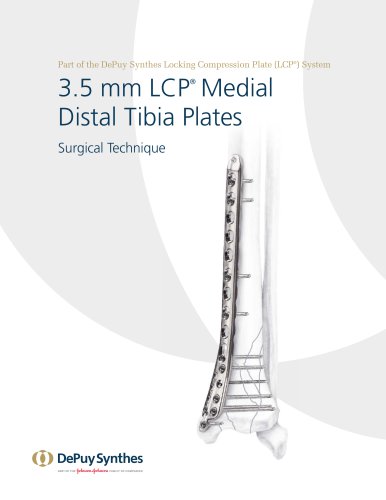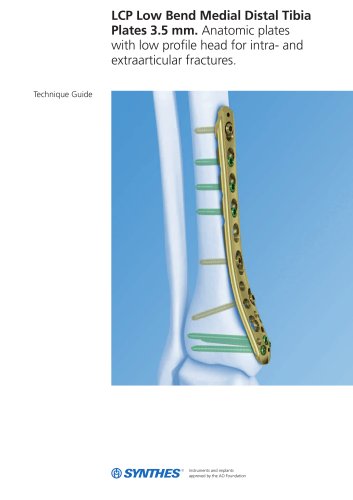 Website:
Depuy Synthes
Website:
Depuy Synthes
Group: Johnson & Johnson
Catalog excerpts
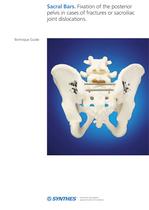
Sacral Bars. Fixation of the posterior pelvis in cases of fractures or sacroiliac joint dislocations. Technique Guide
Open the catalog to page 1
Introduction Sacral Bars 2 Surgical Technique Preoperative Planning 5 Product Information Sacral Bar Sets 11 Synthes Biomaterials Overview 13 This description alone does not provide sufficient background for direct use of the product. Instruction by a surgeon experienced in handling this product is highly recommended Reprocessing, Care and Maintenance of Synthes Instruments For general guidelines, function control and dismantling of multi-part instruments, please refer to: www.synthes.com/reprocessing
Open the catalog to page 3
Sacral Bars. Fixation of the posterior pelvis in cases of fractures or sacroiliac joint dislocations. − Sacral washers prevent the rounded sacral nuts from pressing into the cortical bone − The sacral bars feature a trocar tip for easy passage through the soft tissues − The sacral bars are fully threaded and are available in 200 mm or 260 mm lengths − The implants are not in direct contact with the neurological structures of the Os sacrum which reduces the risk for iatrogenic injuries 2 Synthes Sacral Bars Technique Guide
Open the catalog to page 4
AO Principles In 1958, the AO formulated four basic principles, which have become the guidelines for internal fixation.1, 2 Those principles as applied to the sacral bars are: Anatomic reduction Fixation of sacral fractures and fracture dislocations of the sacroiliac joint with the threaded sacral bars allows the restoration of anatomical relationships. Stable fixation Hexagonal and rounded sacral nuts can be wedged against each other and thus compression can be achieved. The recommended two-bar technique adds stability to the construct. Preservation of blood supply The sacral bars bridge...
Open the catalog to page 5
The Synthes Sacral Bars are indicated for fixation of the pos- terior pelvis, in areas of the posterior superior iliac spine, posterior inferior iliac spine, for sacral fractures, and fracture dislocations of the sacroiliac joint. 4 Synthes Sacral Bars Technique Guide
Open the catalog to page 6
Preoperative Planning 321.200 Ratchet Wrench for Nut, hexagonal, This procedure can be performed manually using a universal chuck with T-handle, or with power equipment. Note: In the case of bilateral fracture, it is necessary to have at least one side of stable reduction using a sacroiliac screw or posterior plate in addition to inserting sacral bars. The correct length of the sacral bar should extend 25-30 mm on either side of the posterior iliac crest (bar will For additionally required instruments, please see page 12.
Open the catalog to page 7
Surgical Technique The patient is placed in the prone position. Make slightly curved bilateral incisions just lateral to the pos- terior superior iliac spine. The incision on the fracture side should be large enough to allow for direct visualization and 6 Synthes Sacral Bars Technique Guide
Open the catalog to page 8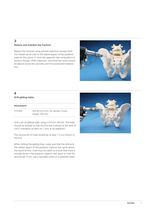
Reduce and stabilize the fracture Reduce the fracture using pointed reduction forceps from the medial sacral crest to the lateral aspect of the posterior superior iliac spine, or from the opposite side using pelvic re- duction forceps. After reduction, two Kirschner wires should be placed across the sacroiliac joint for provisional stabiliza- Drill gliding holes 310.60J Drill Bit 6.0 mm, for Jacobs Chuck, Drill a set of gliding holes using a 6.0 mm drill bit. The holes should be located so that the first bar is placed at the level of L5/S1 interspace as seen on C-arm or by palpation. The...
Open the catalog to page 9
Surgical Technique 5 Insert first sacral bar Instruments 296.763 or 296.766 Threaded Sacral Bar, length 200 mm, Stainless Steel Threaded Sacral Bar, length 260 mm, Stainless Steel Drive the sharp trocar tip of the threaded sacral bar through the predrilled hole in the contralateral iliac spine. The sacral lamina must be seen, to ensure that the bar passes dorsal to it and does not enter the sacral canal; it may pass through the medial sacral crest. 6 Apply washers and rounded nuts Instruments 296.758 Washer л 6.0 mm 296.757 Nut, rounded, л 6.0 mm 321.160 or 321.200 Combination Wrench л 11.0...
Open the catalog to page 10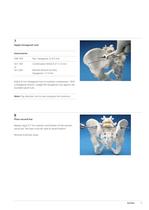
7 Apply hexagonal nuts Instruments 296.759 Nut, hexagonal, л 6.0 mm 321.160 or 321.200 Combination Wrench л 11.0 mm Ratchet Wrench for Nut, hexagonal, 11.0 mm Add 6.0 mm hexagonal nuts to maintain compression. With a hexagonal wrench, wedge the hexagonal nuts against the rounded sacral nuts. Note: Pay attention not to over-compress the construct. 8 Place second bar Repeat steps 5–7 for insertion and fixation of the second sacral bar. Two bars must be used to avoid rotation. Remove Kirschner wires. Synthes 9
Open the catalog to page 11
Surgical Technique 9 Trim sacral bars Instrument 388.720 Bolt Cutter Use the bolt cutter to cut the ends of the sacral bars flush with the hexagonal nuts. 10 Synthes Sacral Bars Technique Guide
Open the catalog to page 12
Each set contains the necessary sterile implants and drill bit for one surgical procedure as described in the technique Bar Length 200 mm, sterile Bar Length 260 mm, sterile 01.100.763 contains the following implants and instruments: 296.763S* Threaded Sacral Bar, length 200 mm, 0 6.0 mm. Stainless Steel, sterile 2 310.60JS Drill Bit 6.0 mm, for Jacobs Chuck, 01.100.766 contains the following implants and instruments: 296.766S* Threaded Sacral Bar, length 260 mm, 0 6.0 mm. Stainless Steel, sterile 2 310.60JS Drill Bit 6.0 mm, for Jacobs Chuck,
Open the catalog to page 13
Additional Instruments The following instruments are additionally required: Ratchet Wrench for Nut, hexagonal, Bolt Cutter Universal Chuck with T-Handle Also available: 398.860 Pelvic Reduction Forceps, long, with pointed ball tips, speed lock, Oscillating Drill Attachment 12 Synthes Sacral Bars Technique Guide
Open the catalog to page 14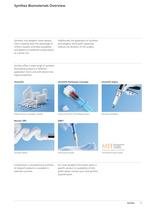
Synthes Biomaterials Overview Synthetic and allogenic bone replacement materials have the advantage of uniform quality, unlimited availability and absence of potential complications at a donor site. Additionally, the application of synthetic and allogenic bone graft substitutes reduces the duration of the surgery. Synthes offers a wide range of synthetic biomaterial products in different application forms and with distinct biological properties: chronOS chronOS Perfusion Concept chronOS Inject Osteoconductive, resorbable, synthetic Enhancing chronOS with biological factors Injectable...
Open the catalog to page 15All Depuy Synthes catalogs and technical brochures
-
ZERO-P NATURAL™PLATE
5 Pages
-
2.0 mm LCP® Distal Ulna Plate
20 Pages
-
SYNFLATE SYSTEM
3 Pages
-
2.4 mm VA LCP™
4 Pages
-
Building on Success
16 Pages
-
HEALIX ADVANCE
4 Pages
-
RADIUS OF CURVATURE
3 Pages
-
Introducing The Variable Angle
12 Pages
-
HEALIX Anchor™ 3.4 mm
2 Pages
-
Small Battery Drive II
4 Pages
-
HEALIX ADVANCE
4 Pages
-
3.5 mm LCP™ Medial
15 Pages
-
Titanium Sternal Fixation System
34 Pages
-
MatrixRIB®FixationSystem
86 Pages
-
Mandible Trauma Solutions
2 Pages
-
Power line II
4 Pages
-
Concorde
28 Pages
-
LCP Intercarpal
31 Pages
-
LCS® COMPLETE™
2 Pages
-
Synthes TPLO.
8 Pages
-
SynFix-LR System
56 Pages
-
ATB Anterior Tension Band Plate
32 Pages
-
CONDUIT™
15 Pages
-
Brochure_FINAL
2 Pages
-
DePuy Synthes
81 Pages
-
Anspach
3 Pages
-
Orthopedic Foot Instruments
32 Pages
-
PINNACLE® Hip Solutions
12 Pages
-
Corail
24 Pages
-
S-ROM® NOILES™
68 Pages
-
TRI-LOCK® Product Rationale
12 Pages
-
Reclaim Surgical Technique
44 Pages
-
Speed
2 Pages
-
attune
80 Pages
-
HAMMERLOCK® 2
2 Pages
-
DePuy Glenoid Solutions
2 Pages
-
Trauma Solutions. Elbow
4 Pages
-
Polar
4 Pages
-
Alveolar Distractor.
4 Pages
-
Piezoelectric System
4 Pages
-
Air Power Line II
6 Pages
-
LCP Clavicle Hook Plate
4 Pages
-
TruMatch Pin Guides
16 Pages
-
P F N A
8 Pages
-
SKILL, DEDICATION,
16 Pages
-
Orthopaedics. Overview
20 Pages
-
DURALOC
16 Pages
-
Marathon Cemented Cup
20 Pages
-
REEF Surgical Technique
16 Pages
-
MatrixNEURO
8 Pages
-
Anspach XMax
4 Pages
-
Anspach eMax 2 Plus
4 Pages
-
Small Electric Drive
4 Pages
-
Air Pen Drive
4 Pages
-
Colibri II
4 Pages
-
Spine
25 Pages
-
Expert Hindfoot Arthrodesis Nail
48 Pages
-
LCP Distal Fibula Plates
32 Pages
-
TomoFix
60 Pages
-
Expert Tibial Nail PROtect
16 Pages
-
Expert Tibia Nail
84 Pages
-
Pelvic C-Clamp
20 Pages
-
Low Profile Pelvic System
16 Pages
-
Proximal Femoral (Hook) Plate
24 Pages
-
LCP
24 Pages
-
PFNA
112 Pages
-
HCS 1.5, 2.4, 3.0
36 Pages
-
LCP Wrist Fusion
32 Pages
-
LCP Compact Hand
28 Pages
-
VA-LCP Elbow
48 Pages
-
Distal Radius
44 Pages
-
Olecranon
30 Pages
-
LCP Hook Plate
28 Pages
-
DHP & Olecranon
4 Pages
-
LCP S-A
4 Pages
-
Epoca
4 Pages
-
Philos
32 Pages
-
MultiLoc
68 Pages














